In a nutshell…
Unbounce surveyed 750 consumers and 395 marketers, and—while both groups already know slow page load times affect consumer behavior—nobody’s doing enough to avoid the consequences.
Key Findings:
- When it comes to waiting for pages to load, most consumers think they’re more patient than they actually are.
- Nearly 70% of consumers admit that page speed impacts their willingness to buy from an online retailer.
- Although they know it’s important, the majority of marketers aren’t making page speed a priority.
Page speed should concern marketers, but does it?
Over the past three years, the average web page has doubled in size1 while connection speeds have remained stable. And so, the average time it takes for a page to load on mobile is now 15 seconds.2 Given that more than half of visitors leave a page if they’re forced to wait longer than 3 seconds,3 marketers need to get faster.
Like, way faster.
That was our hunch, anyway, but we wanted to investigate. At 2018’s Call to Action Conference (CTAConf) in Vancouver, we chatted with 188 attendees to look at the performance of their landing pages. During a brief session, they ran a page through Google’s “Test My Site” tool to see how fast it loaded. Despite the small sample size, the results startled us:
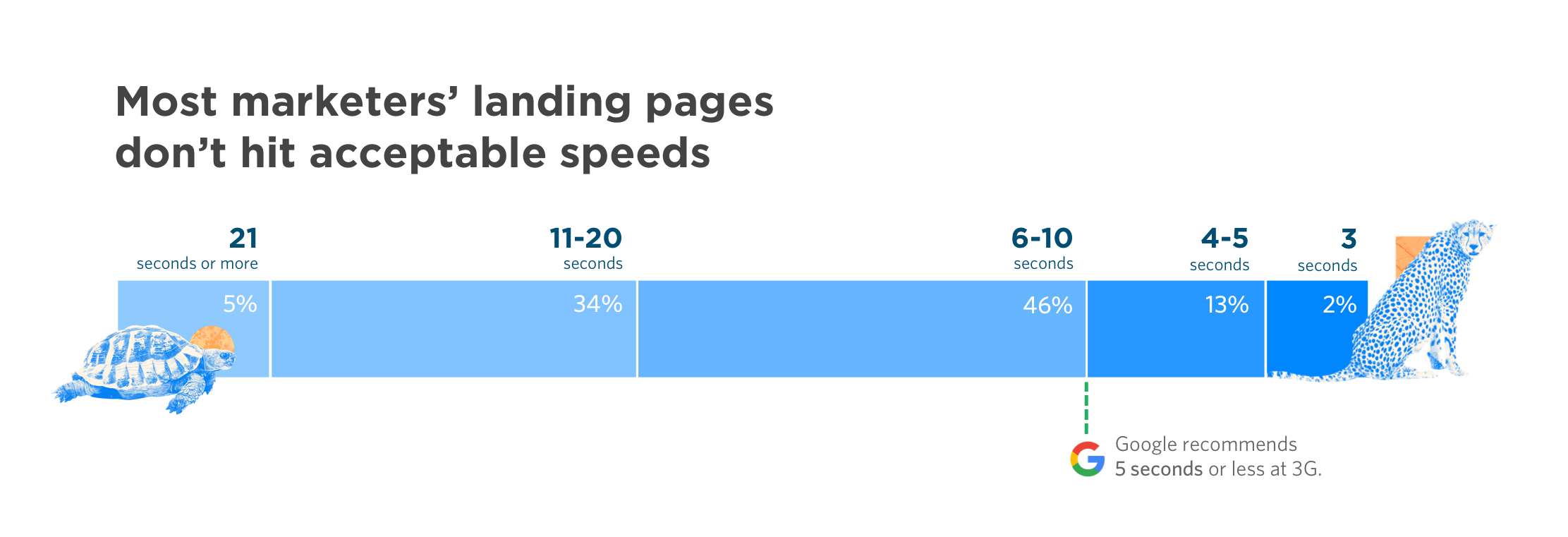
Most marketers aren’t hitting speeds that put them in Google’s good books. Because they’re too slow, they’re likely paying more than they need to for their search ads—and disappearing completely from organic search results.
And when their visitor experience is slower than expected, potential customers are more likely to become frustrated and leave. Some of ‘em even head to the competition. Why? According to Andy Crestodina at Orbit Media, there’s a pretty simple answer:
But we wanted to know more.
Our team wanted to know what both marketers and their customers think when it comes to load times and what obstacles marketers face when trying to speed up.
And so our follow-up surveys sought to answer these key questions:
- Do both groups believe page speed influences consumer behavior? If so, what’s the nature of this influence?
- For marketers, how much of a priority is improving page speed? What are they doing (or planning on doing) to improve it?
- And what do marketers think about Accelerated Mobile Pages (AMP)? Do they know what they are?
Here’s what we discovered…
Consumers don’t like slow pages.
We asked 750 everyday people about what happens when web pages are slow to load. Turns out they react in all sorts of ways that negatively affect your conversions.
When it comes to waiting, most consumers think they’re more patient than they actually are.
Almost three-quarters of the shoppers we surveyed claim they’ll wait 4 or more seconds before abandoning a page. But that’s not what Google says: remember, actual user behavior shows most people bounce after 3 seconds.
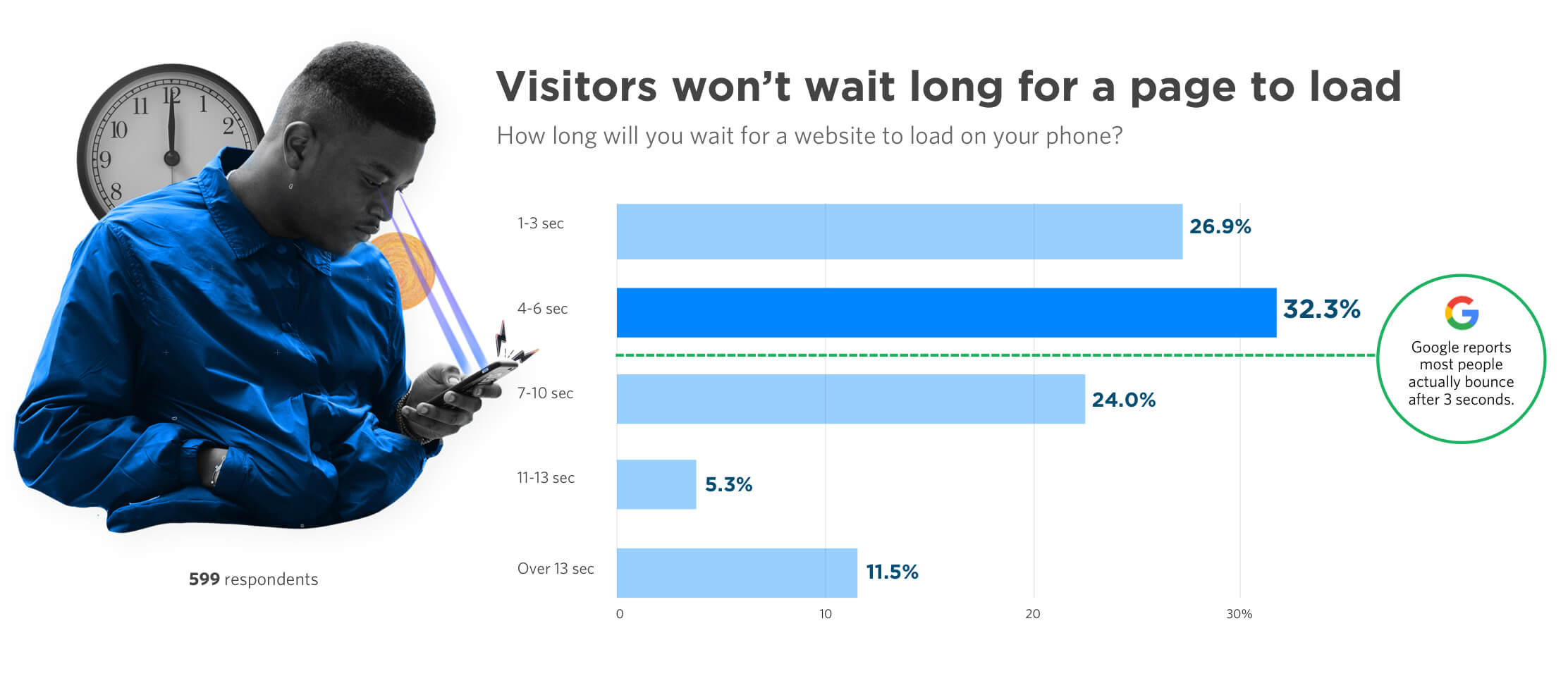
Nearly 70% of consumers admit that page speed influences their likeliness to buy.
When it comes to browsing ecommerce sites, many people say they’re less likely to make a purchase (or even less likely to return in the future) if loading time is slower than expected. If you want them to buy your product, you need to ensure your site loads as quickly as possible, especially on a mobile phone.

Half of all people say they’d be willing to give up animation and video for faster load times.
All those beautiful animations and videos that marketers love? Turns out a majority of your visitors don’t see much value in these elements if it’s going to slow them down. Heck, a quarter of respondents say they’d be willing to give up images as well! Think carefully before you include anything in your design that will slow your page down. If it doesn’t serve a purpose, consider cutting it.

Most consumers blame their internet connection before they blame your site. (Phew!)
Right now, it’s true that most people credit slowdown on factors outside of your control (like their internet provider). And hey, that’s good. But as more online brands improve performance, it’s likely that sites that stay slow will start to shoulder more of the blame.

According to analyst Peggy Anne Salz, the “lean-back experience of the laptop/desktop is a boost to consumers’ patience” but not all the time. Whether a page is intended for mobile or desktop viewing, delivering blazing speeds is always going to lead to less frustration:

Takeaway: Speed matters to your prospects, so it should matter to you.
Our survey results show that the load time of a page can impact how a visitor will interact with it in significant ways. Ideally, a page should load in under 3 seconds, even on mobile, so creating a speedy visitor experience should be your priority. That’s why Unbounce automatically optimizes our landing pages for fast delivery.
81% of marketers know speed influences their conversions, but they’re not making it a priority.
49% of marketers say they plan to spend $50,000 or more—sometimes way more—on their digital marketing. A majority also agree that improving load times is at least somewhat urgent.
But only a small percentage say it’s the most critical thing of their to-do list, despite the clear impact on their prospects’ willingness to make a purchase. In fact…
Only 3% of marketers say faster loads are their top priority.
Most marketers consider A/B testing and optimizing for more conversions to be their most important tasks. (We think A/B testing is important too.) But here’s what else they say they’re prioritizing over faster loading time:

Krista Seiden, Analytics Advocate for Google, confirms that digital marketers are neglecting page speed (and that it’s a major problem):

Krista Seiden
Analytics Advocate, Google
Many marketers are unsatisfied with their page speed, and most have taken some steps to improve it.
While improving load times isn’t their number one priority, marketers are taking some steps—if only optimizing images—to deliver faster speeds. Only 56% say they’re satisfied, though.

…but what are marketers doing to get faster?
- 57% say they’ve optimized images, video, or other media files.
- 43% have implemented back-end fixes like improved caching and hosting solutions.
- 39% have run speed audits using Google Lighthouse or other tools.
- 38% minified or reduced their dependence on JavaScript and CSS.
- 22% implemented Accelerated Mobile Pages (AMP) in some capacity.
- 14% began using a Content Delivery Network (CDN).
Most marketers know what load times they should target, but are they getting there?
A significant number of marketers say that 2-3 seconds is an acceptable load time, which is right on target with Google’s recommendation. Remember, though, that 85% of participants at CTAConf showed us landing pages slower than Google’s recommendation of 5 seconds or less!
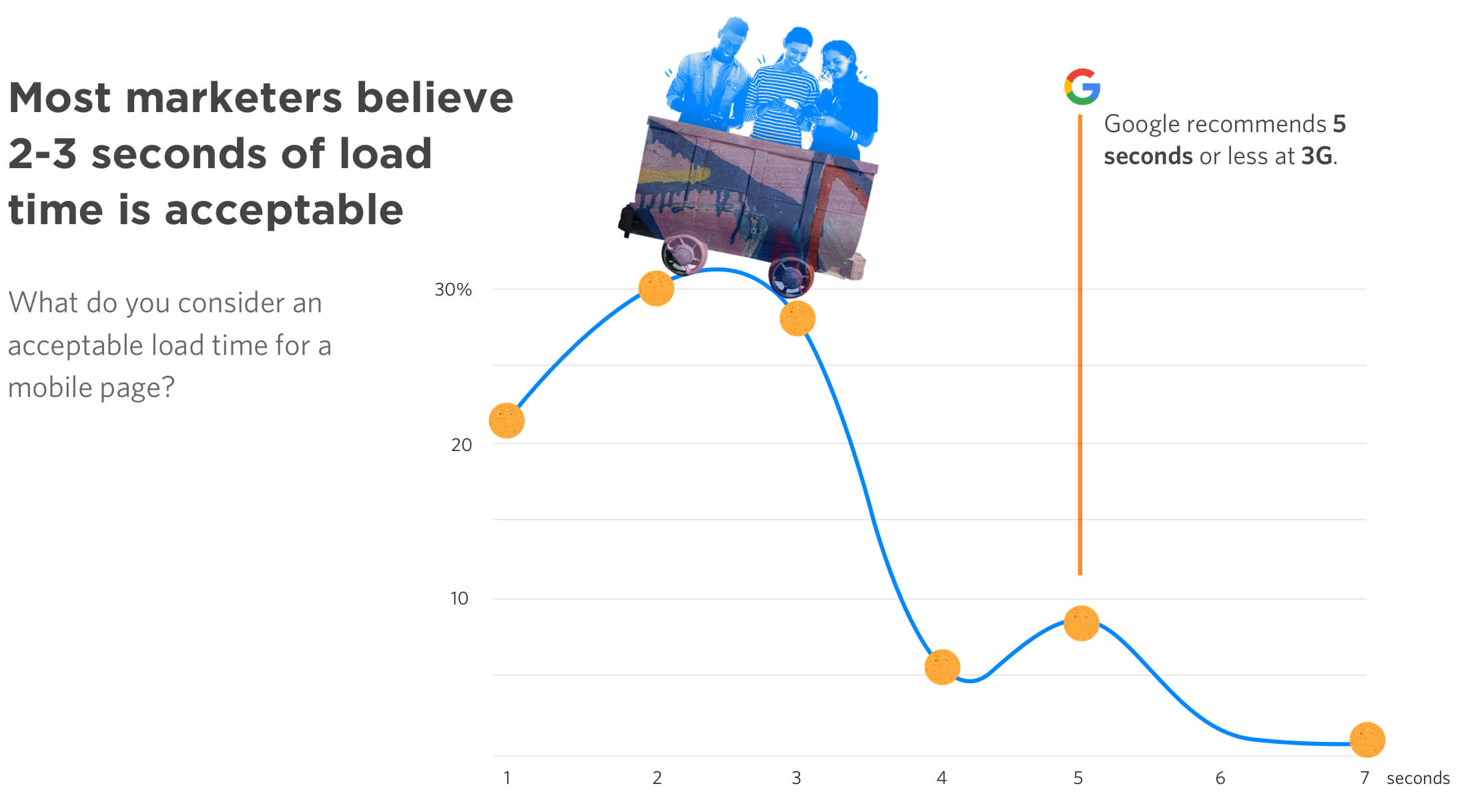
Rand Fishkin, founder of Moz and SparkToro, says speed is a “crucial component for so much of what creates a great experience that converts visitors to buyers.” There are many reasons you’ll want to speed up:

Takeaway: We marketers know that getting faster is essential, but we’ve had other priorities.
And who could blame us? Delivering speedy pages can be complicated, and there are so many other tasks demanding our attention. Here are some steps recommended by Google:
- Conduct a speed audit. Run your pages through Google’s PageSpeed Insights or Unbounce’s Landing Page Analyzer to see how they stack up.
- Ensure all your media (images, videos, etc.) is optimized for mobile. Use smaller file types, like SVG, whenever possible.
- Remove unnecessary plugins, add-ons, and scripts. Think hard about what you need to include.
- Use asynchronous loading for analytics and ads services, so you’re not dependent on their loading times.
- Enable browser caching. Reduce the chance your visitors will have to re-download a file they already have on their device.
- Use a Content Delivery Network (CDN) to send files from global servers that are closest to your visitors.
- Enable gzip compression for your pages. Keep your files as small as possible by shrinking fatter files.
- Minify your JavaScript and CSS. Remove all unnecessary characters from the code. Keep only the essentials.
Sound like a lot to worry about? Here at Unbounce, we’ve taken steps to make sure our landing pages hit Google’s recommendations for speed. The best part? We serve up these fixes automatically, with no developer required, so you can focus on your campaigns. With the Auto Image Optimizer and support for Accelerated Mobile Pages (AMP), Unbounce gives you all the tools you need to create a speedier, more engaging visitor experience.
What’s next?
73% of marketers think that improving page speed is either somewhat urgent or very urgent.
That’s a good thing because they’re right. It’s unlikely that consumers are going to grow more patient with your pages.
In the survey, respondents told us that slow speeds impact their decision to buy: many consumers are less likely to buy, and some will even abandon your site for your competitors. And though a majority told us they’d wait longer than 3 seconds, they’re underestimating their own impatience. You shouldn’t.
Simply put, slow page speed is killing your conversions.
Despite this sense of urgency, few marketers are making it a priority. Most are dissatisfied with their speeds, but it’s clear that just optimizing images isn’t cutting it.
For the savvy, this hesitance is an opportunity to get ahead of your competitors in the race.
It’s time to get faster, marketers.
Get faster landing pages now.
Stop wasting your ad budget on clicks that don’t even see your content.
About Unbounce
We’re the leader in landing pages, popups, and sticky bars. Since 2009, we’ve been the conversion platform of choice for marketers. Because we know the impact that page speed can have on conversions, we’re committed to helping our customers deliver the fastest loading times possible.
Methodology
Both surveys were fielded in October/November 2018.
The consumer portion of this survey was conducted by Google Surveys and adheres to their standard (and very rigorous) methodology. We targeted users in the general population of the United States using Google’s publisher network and mobile app. According to Google, “First, we use stratified sampling to dynamically target respondents with the goal of matching the demographics of the target internet population. Next, we apply post-stratification weighting to more closely match those same demographics of the target internet population.” You can read more about their research practices in this white paper. The survey asked 10 questions about their online habits and experiences with slow loading times.
For the marketer survey, adequate sample size was calculated using Cochran’s theorem.7 We gathered responses using a combination of email campaigns, social media channels, and paid advertising. We then screened for respondents in marketer roles. The survey asked 16 questions about their digital marketing as well as opinions about web performance and AMP.
Who participated?
Consumers
We asked 750 everyday consumers a similar series of questions about their attitudes and experiences when it comes to web performance. Here’s who participated:
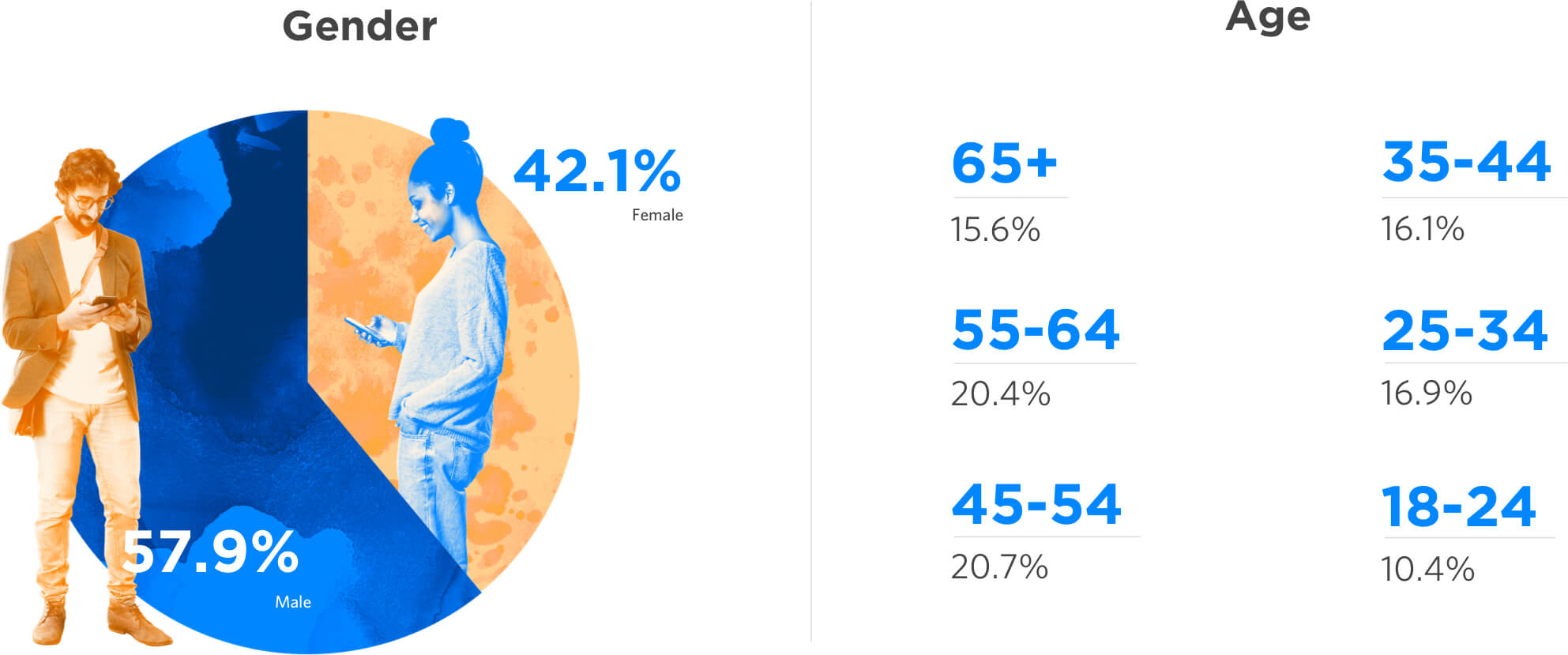
Marketers
We created this report by asking 395 marketers across dozens of industries about the importance of page speed to their online marketing campaigns. Here’s a breakdown:
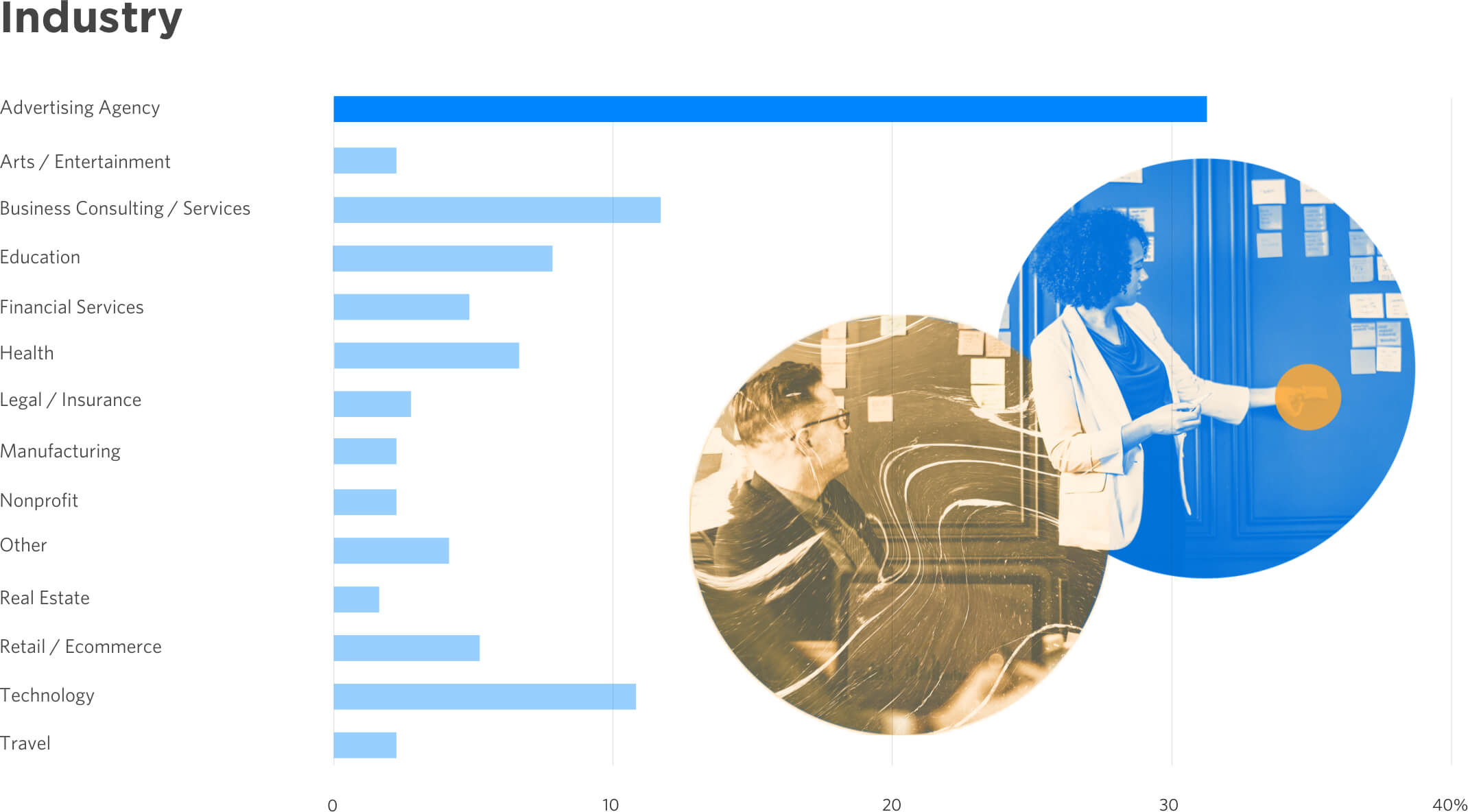

Sources
- Source: MachMetrics, 2018, “Website Size: The Average Web Page Size Is More than 2MB – Twice the Size of the Average Page Just 3 Years Ago”
- Source: Think with Google, 2018, “Find out how you stack up to new industry benchmarks for mobile page speed”
- Source: Think with Google, 2017, “Find out how you stack up to new industry benchmarks for mobile page speed”
- Source: Think with Google, 2018, “A few tips to speed up your mobile site and tools to test it”
- Source: Device Atlas, 2018, “Android v. iOS Market Share 2018”
- Source: Think with Google, 2016, Data Gallery
- Source: Cochran, W.G. (1977). Sampling Techniques, 3rd edn. Wiley. New York.
Contributors

Colin Loughran
Content Creator

Ha Dinh
Data Analyst

Sarah Gooding
PR & Communications Manager

Jennifer Pepper
Marketing Manager, Content Creation

Cecilia Martinez
Interactive Design Lead

Max Tims
Senior Strategy Manager

Rachel Scott
Marketing Manager, Campaign Strategy

Larissa Hildebrand
Product Marketing Manager




